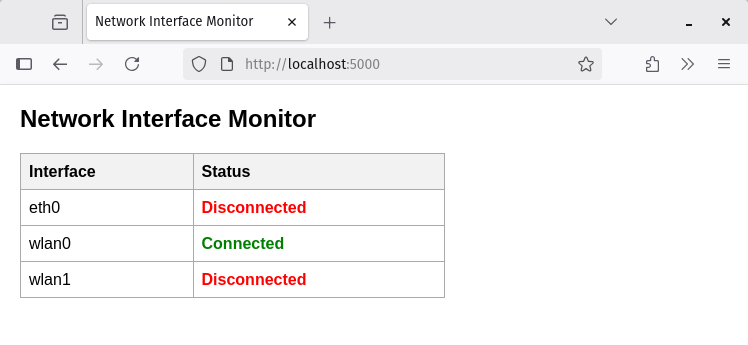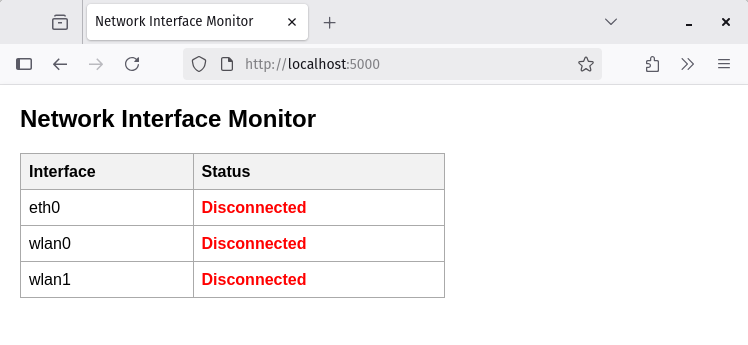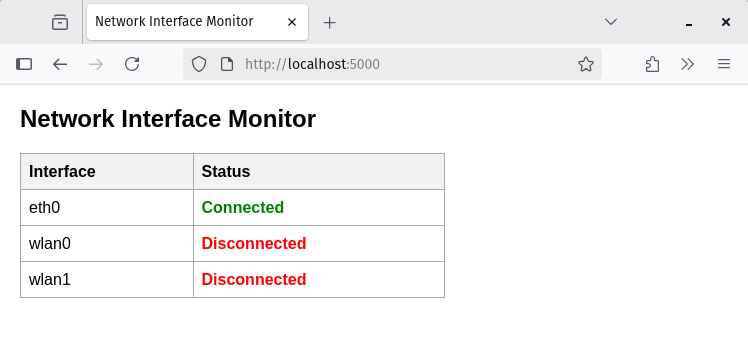Physical Network Interface Status Monitor with Flask

Overview
This project is a simple Flask web application that monitors and displays the
status of physical network interfaces on a machine. It uses the psutil library
to gather network interface statistics and presents them in a user-friendly web
interface that refreshes every second.
PyQt5 version: Physical Network Interface Status Monitor with PyQt5
Feature Highlights
- Real-time Monitoring: The web page automatically refreshes every second to provide up-to-date information on the status of network interfaces.
- Physical Interface Filtering: The application filters out loopback and virtual interfaces, focusing only on physical network interfaces.
- User-friendly Interface: The status of each interface is clearly displayed with color coding for connected and disconnected states.
Screenshots



Use Cases
- Network Administrators: Monitor the status of physical network interfaces on servers or workstations.
- System Monitoring: Integrate into larger system monitoring solutions to keep track of network connectivity.
Technologies Used
- Python: The programming language used to build the application.
- Flask: A lightweight web framework for Python.
- psutil: A cross-platform library for retrieving information on running processes and system utilization (CPU, memory, disks, network, sensors) in Python.
Environment Setup
Python 3.6 or higher is required. It is recommended to use a virtual environment to manage dependencies.
Install dependencies:
pip install Flask psutil
Code
This application is intended for local use or within a trusted network. It does not include authentication or security features. Do not expose it to the public internet without proper security measures.
This application is designed for basic testing and educational purposes and requires modifications to suit specific production environments. For example, auto-refresh is not ideal for production use; WebSockets or AJAX for real-time updates would be better solutions.
from flask import Flask, render_template_string
import psutil
app = Flask(__name__)
TEMPLATE = """
<!doctype html>
<html>
<head>
<title>Network Interface Monitor</title>
<meta http-equiv="refresh" content="1"> <!-- auto-refresh every 1 sec -->
<style>
body { font-family: Arial, sans-serif; margin: 20px; }
table { border-collapse: collapse; width: 60%; }
th, td { border: 1px solid #aaa; padding: 8px; text-align: left; }
th { background-color: #f2f2f2; }
.connected { color: green; font-weight: bold; }
.disconnected { color: red; font-weight: bold; }
</style>
</head>
<body>
<h2>Network Interface Monitor</h2>
<table>
<tr><th>Interface</th><th>Status</th></tr>
{% for iface, connected in interfaces %}
<tr>
<td>{{ iface }}</td>
<td class="{{ 'connected' if connected == 'Connected' else 'disconnected' }}">{{ connected }}</td>
</tr>
{% endfor %}
</table>
</body>
</html>
"""
def get_interfaces():
stats = psutil.net_if_stats()
results = []
for iface, stat in stats.items():
# skip loopback and virtuals
if iface.startswith(("lo", "docker", "veth", "br", "virbr", "vmnet")):
continue
connected = "Connected" if stat.isup else "Disconnected"
results.append((iface, connected))
return results
@app.route("/")
def index():
interfaces = get_interfaces()
return render_template_string(TEMPLATE, interfaces=interfaces)
if __name__ == "__main__":
app.run(host="127.0.0.1", port=5000)
Running the Application
Run the application using the following command:
python main.py
Open web browser and navigate to http://localhost:5000 to view the network interface status monitor.